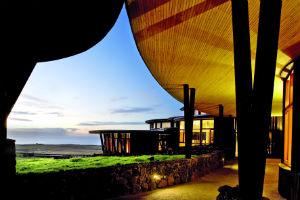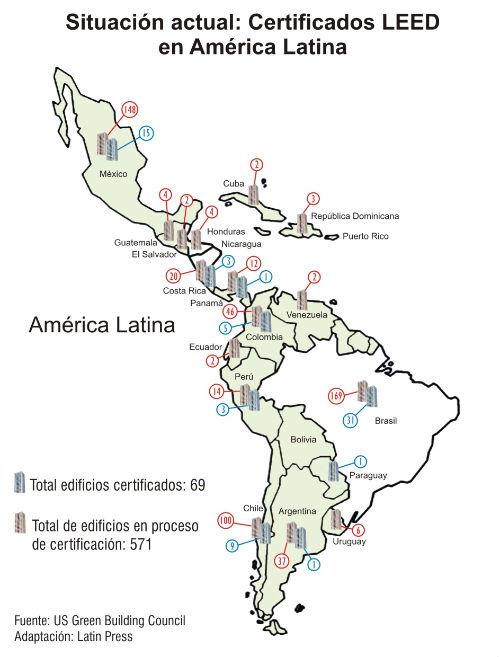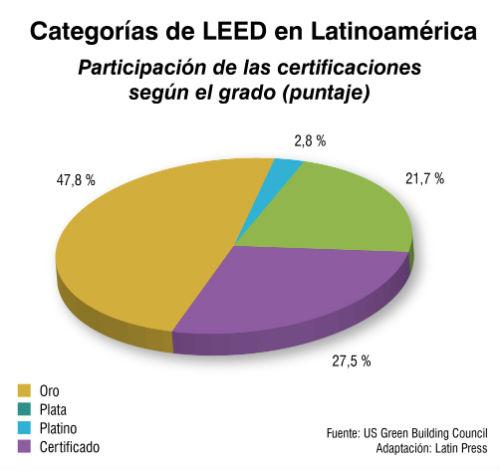 A new economic air has driven the development of sustainable construction in Latin America. Today the USGBC reports more than 500 projects in the process of certification in our region.
A new economic air has driven the development of sustainable construction in Latin America. Today the USGBC reports more than 500 projects in the process of certification in our region.
by Vanesa Restrepo
Although in operation since 1998, the LEED sustainable building certification system has been implemented in Latin America for a short time; However, statistics show a growing interest of builders in this seal that although it does not grant exemptions in the tax burden, it does generate savings in the operation that boost the return on investment.
The official numbers of the US Green Building Council (USGBC), an entity that evaluates and delivers the seal according to a system of pre-established points, indicate that to date there are 69 certified buildings in Latin America, two of them in the superior or Platinum category.
But even more important is the number of buildings in the process of certification. Across the continent there are 571 buildings managing construction systems with lower environmental impact, lower energy and water consumption, and better comfort conditions for their future occupants.
One of the reasons that support this growth is the creation of partnerships equivalent to the USGBC in each country. These entities, although not authorized to deliver the certificate, do work in the promotion of these practices, provide advice in the process and even accompany the projects from their gestation until the moment in which the environmental seal is approved.
Sustainable economic leadership
It is no coincidence that the development of LEED projects is directly proportional to the economic development of Latin countries. If you look at the map (Graph 1), you will find that Brazil, which is the country with the best growth figures in its economy, is also the country with the highest number of certified buildings, 31 in total; as well as with a greater number of buildings in the process of obtaining the green seal, with 169.
The director of the Green Building Council of Brazil, Maria Clara Coracini, explained that in her country there is no tax exemption system for buildings seeking certification, but that there is a system of discounts on credits granted by the National Development Bank, BNDES, which is valid for hotels and stadiums that have less environmental impact.
He added that the entity he represents has developed a national education program that qualifies professionals, disseminates information, promotes networking among the different participants involved with sustainable construction and functions as a facilitator before the certifying entity and those responsible for the management of the certification.
Mexico, which these days is in the process of economic recovery after the global crisis, ranks second in activity related to LEED. In that country there are 15 certified buildings and 48 more in the process of certification, according to USGBC statistics.
The third place in volume of certifications and current processes is in Chile, where there are already nine buildings with LEED seal and another 100 await approval.
The fourth position is occupied by Colombia, a country whose industrial and economic development has remained stable in recent years. In that nation there are five certified buildings and 46 more await the approval of their seal.
The director of the Colombian Council of Sustainable Buildings, Cristina Gamboa, pointed out that although today there are no incentives for sustainable construction, the national government has already given instructions for its formulation and development through the National Development Plan 2010 -2014- "A fundamental element of this policy is the Colombian Environmental Seal for Sustainable Buildings, which has been in formulation since 2010 and which we hope to have by mid-2012," he added.
In the south of the American continent there is also an interest in the development of sustainable constructions; in Argentina, for example, despite the fact that there is only one certified construction, there are 37 more that have already filed their request for approval with the USGBC, in Paraguay there are already six projects about to be certified and in Uruguay there is already a construction with LEED seal.
Even in Central America, the filing of LEED certification projects has skyrocketed with Costa Rica at the head (20 filings and three certificates), Panama (1 certificate and 12 in process), Guatemala and Honduras (four projects filed in each), the Dominican Republic (three projects in progress), El Salvador (two projects filed) and Cuba, which awaits the approval of the certificate for a new construction and a reformed one in Guantanamo Bay.

Actual costs
Critics of the LEED environmental certification system have pointed to the costs of the process as one of the main disadvantages of the system; however, the directives of the Sustainable Building Councils in Latin America have been in charge of estimating the costs to demonstrate that the cost-benefit ratio of such a system makes sustainable construction emerge as the predominant option in the coming years.
According to Maria Clara Coracini, the costs linked to the registration of the project and the entire certification process before the corresponding authorities mean 0.01% of the total cost of the project. In the case of Brazil, which Coracini knows perfectly, this process requires the investment of one real (on average US$0.56) for each square meter built.
There is another expense that, despite not being mandatory, is considered necessary for the correct procedure: consulting, whose estimated cost varies between 0.5% and 1% of the total value of the project. "A LEED consultant is trained and qualified to assist in the certification process and support the sustainable construction practices implemented, simulate energy consumption and audit the processes executed by third parties," said the official.
Add to that leed-certified buildings have less expensive operations and consume fewer resources, so the return on investment for builders is shorter. "These buildings have lower operating costs and offer conditions for a greater valuation of the properties, compared to buildings without sustainability attributes," explained Cristina Gamboa, of the Colombian Council of Sustainable Construction.
To highlight
Benefits for all
According to the Colombian Council for Sustainable Construction, headed by Cristina Gamboa, sustainable buildings carry a series of environmental and social benefits. Among the environmental benefits, it seeks to improve the performance of the built environment in areas of high impact, including:
1. Lower energy consumption (30%-50%) and water (40%).
2. Lower generation of greenhouse gas emissions in their useful life (35%).
3. Less generation of construction debris and reduction in the use of new materials by recycling and reuse (70%).
Among the social ones derived from a sustainable urban design are:
1. The adequate provision of public space and equipment.
2. Priority to pedestrian mobility, public transport and alternative means such as cycling.
3. The balanced mix of uses favors urban dynamics, reduces the need for displacement (located in the same area housing, employment, culture, sport and recreation).
4. As for housing, especially VIS, users enjoy a better quality of life and achieve a greater ability to pay by reducing the consumption of public services, which translates into the possibility of satisfying other household needs.
To highlight
Greenest buildings in Latin America
Statistics from the US Green Building Council reflect the increase in green buildings in Latin America. Taking as a reference the scoring system devised by this entity to categorize LEED projects, it is found that two projects have obtained the highest score in Latin America (platinum): Eldorado Buiness Tower in Brazil and Bioconstruction Offices in Mexico.
Meanwhile, in the gold category there are 33 certified buildings that represent 47.8% of the approved projects (see graph 2). In the Silver category there are 19 approved projects (27.5% of the total) and in the Certified category that demands fewer points, the seal has been awarded to 15 projects (21.7%) of the total.














